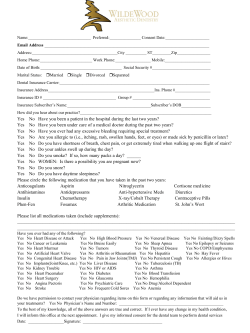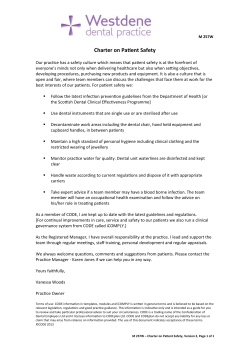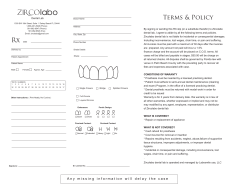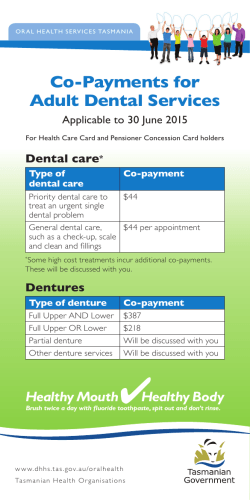
Dental Office Assistant Program Overview Program Objectives
Dental Office Assistant Program Overview The Dental Office Assistant Program prepares students for entry-level employment as a “front-office” dental assistant. It discusses the dental team and the fundamentals of assisting in the management of the dental office, including maintaining patient records, scheduling appointments, using office equipment, and managing accounts receivable and payable. It also provides instruction in dental nomenclature and related terminology, charting the oral cavity, English usage, and finding a job in healthcare. Program Objectives To define and explain different learning styles and learning strategies. To identify the parts of a computer and explain how technology is used in the office. To identify the parts of speech, the parts of sentences, and sentence type. To demonstrate correct English usage by choosing the correct part of speech in a sentence. To evaluate written communications to identify problems and suggest solutions. To describe the duties of a dental office assistant. To identify the correct way to schedule appointments, interact with patients over the telephone, interact with patients in the reception area, order supplies, file documents and records, and manage accounts receivable and payable in the dental office. To identify and define dental nomenclature and related terminology. To chart the oral cavity. Program Outline Unit I: Blackstone’s Skills for Success Chapter 1: Discover How You Learn Chapter 2: Find a Place to Study Chapter 3: Learn How to Study Chapter 4: Keyboarding Unit II: Introduction to Computers, Keyboarding, and Office Technology Chapter 1: Introduction to Computers Chapter 2: The Internet Chapter 3: Other Types of Office Technology Unit III: Dental Office Management 1 Chapter 1: Orientation to the Dental Profession Chapter 2: Dental Basics Chapter 3: Communication Skills and Telephone Techniques Chapter 4: Written Correspondence Chapter 5: Patient Relations Chapter 6: Dental Healthcare Team Communications Unit IV: Dental Office Management 2 Chapter 7: Patient Clinical Records Chapter 8: Information Management Chapter 9: Dental Patient Scheduling Chapter 10: Recall Systems Unit V: English Usage and Written Communication Chapter 1: Parts of Speech Chapter 2: Parts of a Sentence Chapter 3: Pronouns, Verbs, and Agreement Chapter 4: Sentence Types and Punctuation Chapter 5: Written Communications Unit VI: Time & Stress Management Chapter 1: LifeTime Patterns (Values) Chapter 2: The Power of LifeTime Habits Chapter 3: Goals, Objectives, and Outcomes Chapter 4: Choosing Your Priorities Chapter 5: Planning and Scheduling Activities Chapter 6: Interruptions, the #1 TimeThief Chapter 7: TimeLogs Chapter 8: TimeTips Chapter 9: Self-Esteem and Time Management Chapter 10: Stress Management Unit VII: Dental Office Management 3 Chapter 11: Dental Insurance Processing Chapter 12: Inventory Management Chapter 13: Financial Arrangement and Collection Procedures Chapter 14: Bookkeeping Procedures: Accounts Receivable Chapter 15: Bookkeeping Procedures: Accounts Payable Unit VIII: Dental Office Management 4 Chapter 16: Office Equipment Chapter 17: Computerized Dental Practice Chapter 18: Employment Strategies Unit IX: Professional Development and Medicolegal Ethics Chapter 1: Professional Development Chapter 2: Medicolegal Ethics Chapter 3: HIPAA for the Allied Healthcare Worker Unit X: Critical Thinking Skills Chapter 1: Introduction to Critical Thinking and the PANIC Method Chapter 2: Inference and Judgment Chapter 3: Metacognition Chapter 4: Forming Strong Conclusions through Predicting Chapter 5: Rhetorical Strategies Chapter 6: Critical Theories Chapter 7: Deductive Reasoning Chapter 8: Emotional Intelligence and Critical Thinking Unit XI: Dental Office Practice 1 Chapter 1: Monday Chapter 2: Tuesday Unit XII: Dental Office Practice 2 Chapter 3: Wednesday Chapter 4: Thursday Unit XIII: Dental Office Practice 3 Chapter 5: Friday Chapter 6: Critical Thinking Questions Unit XIV: Creating an Effective Workplace Environment Chapter 1: Aspects of a Positive Workplace Environment Chapter 2: Communication Chapter 3: Diversity in the Workplace Chapter 4: Team Building Unit XV: Management Practices & Principles Chapter 1: The Supervisor: Manager and Leader Chapter 2: Effective Communication Chapter 3: Creating a Positive Work Climate Chapter 4: Building Teams and Managing Conflict Chapter 5: Delegation Chapter 6: Developing Job Expectations Chapter 7: Recruiting Employees Chapter 8: Selecting Employees Chapter 9: Orienting and Training Employees Chapter 10: Performance Evaluation Chapter 11: Disciplining Employees Unit XVI: How to Find a Job in Healthcare Chapter 1: Job Search Correspondence Chapter 2: The Job Search Chapter 3: Job Interviews
© Copyright 2025









